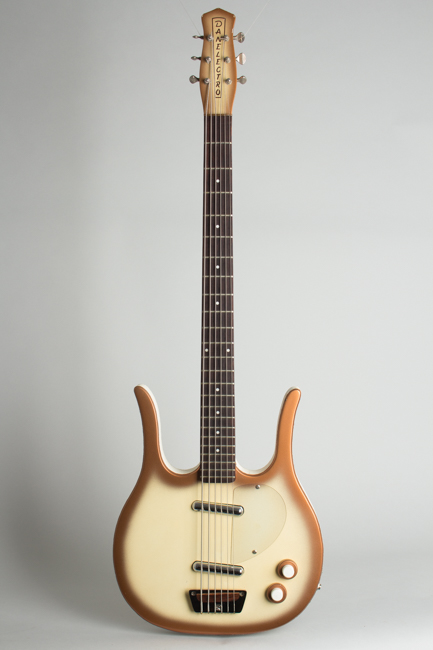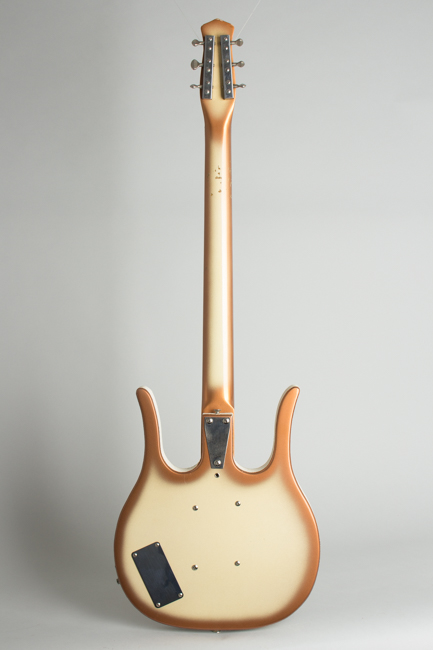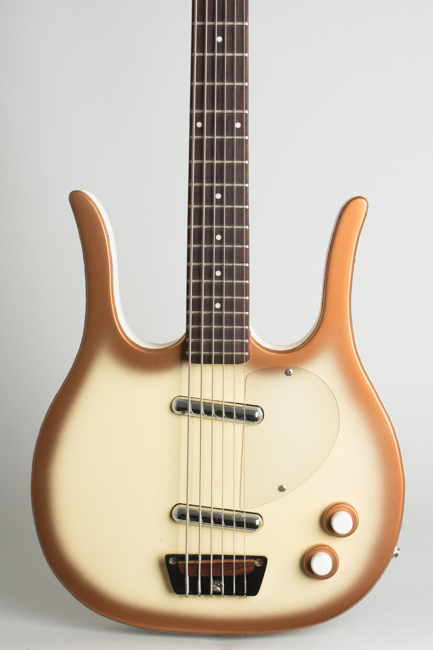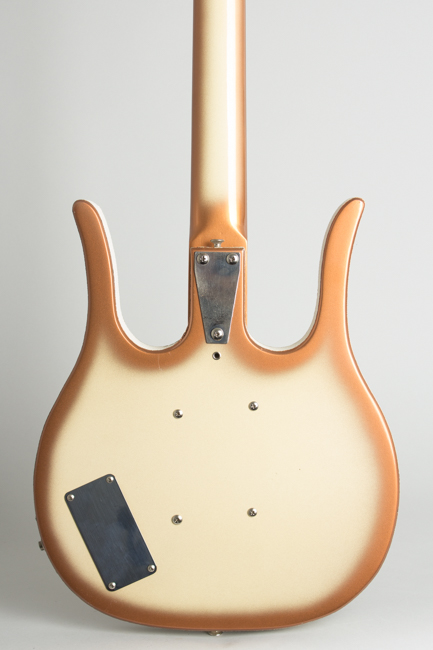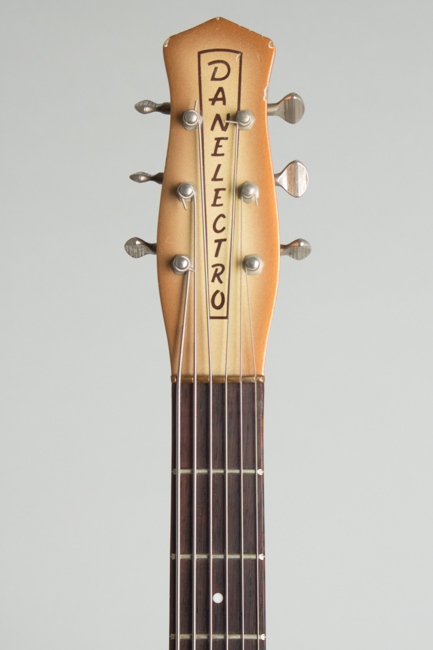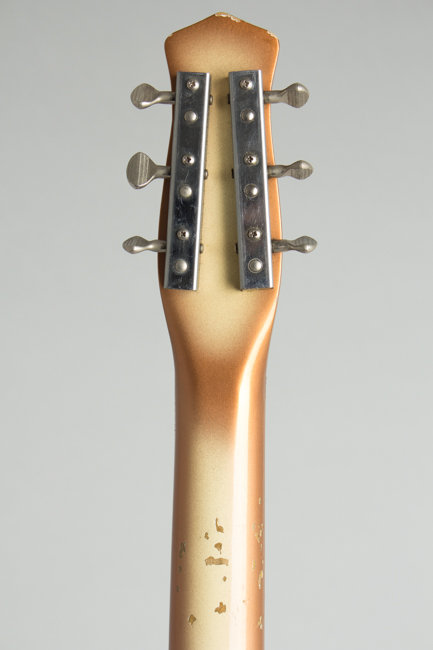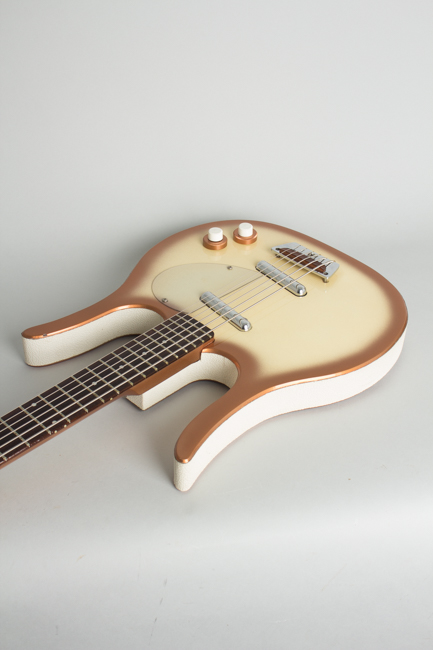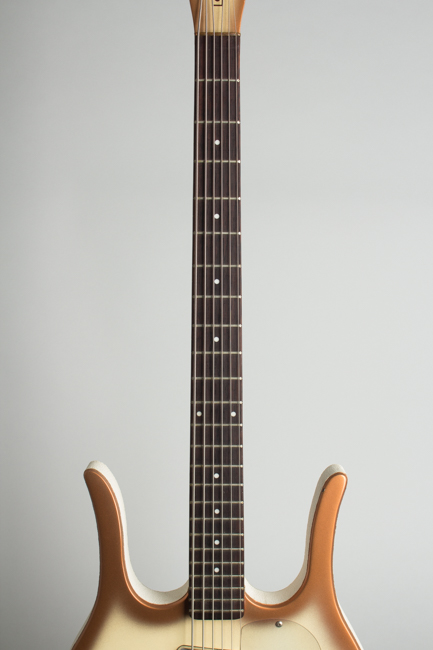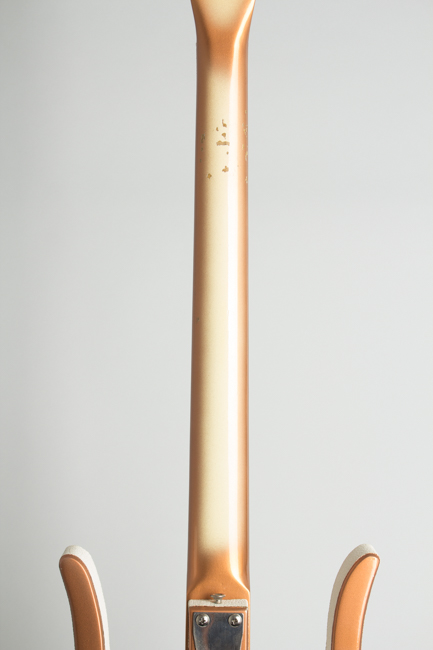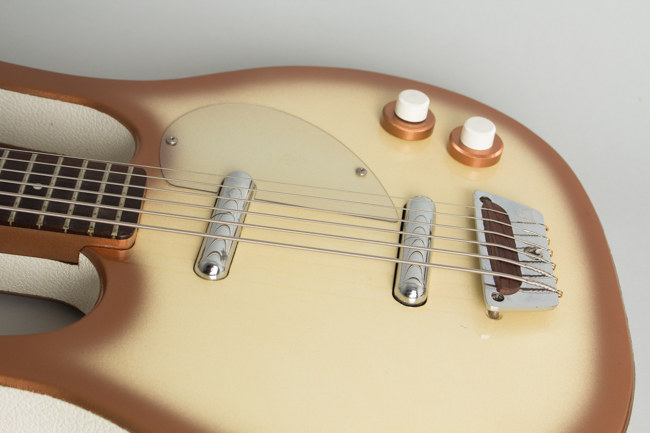Danelectro Longhorn Model 4623 Electric 6-String Bass Guitar , c. 1967
This item has been sold.
Item # 9520
Prices subject to change without notice.
Danelectro Longhorn Model 4623 Model Electric 6-String Bass Guitar, c. 1967, made in Neptune, NJ, bronze lacquer finish, masonite and pine body, poplar neck with rosewood fingerboard, tweed hard shell case.
The 6-string Longhorn Model 4623 is a serious rarity and simply one of the coolest bass guitars ever designed! And it IS a "Bass Guitar", a 6-string instrument originally intended to be tuned an octave below standard. This was one of Nathan Daniels' gifts to the world, as he put it "I gave bass players two extra strings for free!" The Danelectro Longhorn Model 4623 was introduced in the company's 1958 catalog alongside a matching "regular" 4-string bass and 6-string "Guitarlin" guitar. After a quick re-location of the treble pickup farther back on the body in 1959, the Longhorn basses survived up into the late 1960s with only minor alterations.
Listed for the entire run at $150.00, this was Danelectro's most expensive bass instrument up until almost the end. Despite being one of the New Jersey company's best-remembered creations, the Longhorn series are all actually fairly rare, especially so in this 6-string bass format. Longhorns were heavily outsold by the "Standard" models (called "shorthorns" in retrospect) that retailed around $50.00 less in the '60s; it seems most Danelectro users were budget conscious even then!
Then and now, the Longhorn is always a delight to play. The body size and shape is identical on all three models, the basses just having a longer 29 1/2" scale neck. Daniel felt the instrument would be a natural for both bassists and guitarists to handle easily. The small, light semi-hollow body is extremely handy and the two Danelectro "lipstick tube" pickups produce a tight and punchy sound. With the short-scale neck set deep into the body and the bridge near the bottom end, the instrument is very compact, no longer than many guitars. The unique bronze/white sunburst finish was the only color scheme offered.
All Longhorns have the same simple but eccentric wiring scheme consisting of just two concentric pots. The upper shaft carries an on/off knob for each pickup with a volume knob on the lower section. The tone of each pickup is pre-set with capacitors and the overall tone of the instrument can be controlled by blending the two. In practice many users found this system confusing or unreliable and most surviving examples have been modified; The 4-string longhorn Jack Bruce used to record DISREALI GEARS in 1967 had already been re-wired! This instrument has all the original electronics and does not appear to have been altered at all.
This particular bass is also a very late example. The ink stamp on the neck heel indicates that part was fabricated in 1964, but other features point to a date of assembly for the complete instrument around 1966-7 when VERY few of these were being sold. These include a Coral-style neck plate with the "tilt-neck" adjustment beneath it, Danelectro in-house "Skate key" tuners and a stock brass nut in place of the earlier aluminum one, a feature shared with the upscale 1967 Coral guitars. The bridge is the standard ubiquitous Dann-O item, a metal plate adjustable for height with a sliding rosewood saddle. The upper knobs on the split-shaft pots are the same round white pieces used on the Silvertone amp-in-case guitars in place of the earlier fussy-to-make wooden flippers. The 4-screw control plate is installed over the holes already drilled for the older 2-screw setup. This is likely one of the very last of these original 6-string basses ever built.
While rarely seen onstage, Nathan Daniel's guitar-like bass did prove a hit in recording studios, especially in Nashville. Session players developed a style of playing with a palm-muted pick, dubbed "Tic-Tac" bass. Within a short time this became a widely heard sound. Well before the Fender Bass was accepted on many record sessions, Danelectro was the hot new sound...many twanged away in the late '50s and '60s, unseen but easily heard on hundreds of recordings and particularly in TV and film soundtracks. One would think the wicked looks would have inspired more live use -- vintage-style rocker Dave Edmunds used one prominently on his INFORMATION album in the early 1980s, and duly posed with it on the cover.
We are extremely pleased to offer this spectacular and very rare 6-string example of one of our favorite instruments, the immortal Longhorn. A salute to Nathan Daniel is in order, for creating this one-of a kind twang machine in the first place.
Overall length is 39 3/4 in. (101 cm.), 13 1/8 in. (33.3 cm.) wide at lower bout, and 1 9/16 in. (4 cm.) in depth at side. Scale length is 29 1/2 in. (749 mm.). Width of nut is 1 5/8 in. (41 mm.).
This is one of the cleanest and most original 1960s Danelectro Longhorns we have seen, showing very little play time from the last 50+ years. If not for some finish chipping primarily on the neck and headstock edges this one would rate an EX++. The back of the neck has a number of small chips and dings to the undercoat around the 2nd-3rd fret area. If not for this, there would be only some tiny finish chips, scratches and dings on this amazingly well-kept bass. The hardware shows some minimal wear as well, but really it looks like this one is still waiting to be seriously played.
This is also a very fine player with a near-perfect neck. It remains completely original, as God and Nathan Daniel intended when it left the loading dock at Neptune (New Jersey, that is). This instrument was designed and is currently strung as a 6-string bass (tuned E-E) but can also be easily strung and tuned for the more currently fashionable B-B or A-A Baritone setup. This striking rarity sounds fantastic in either tuning and looks wicked as all get-out doing it. Simply as cool as they come; so sparkling in its white-bronze appliance burst it looks on first glance like a re-issue. This is THE genuine 1960s American Masonite and poplar here, a proud product of Nathan Daniels' offbeat genius. Excellent Condition.
The 6-string Longhorn Model 4623 is a serious rarity and simply one of the coolest bass guitars ever designed! And it IS a "Bass Guitar", a 6-string instrument originally intended to be tuned an octave below standard. This was one of Nathan Daniels' gifts to the world, as he put it "I gave bass players two extra strings for free!" The Danelectro Longhorn Model 4623 was introduced in the company's 1958 catalog alongside a matching "regular" 4-string bass and 6-string "Guitarlin" guitar. After a quick re-location of the treble pickup farther back on the body in 1959, the Longhorn basses survived up into the late 1960s with only minor alterations.
Listed for the entire run at $150.00, this was Danelectro's most expensive bass instrument up until almost the end. Despite being one of the New Jersey company's best-remembered creations, the Longhorn series are all actually fairly rare, especially so in this 6-string bass format. Longhorns were heavily outsold by the "Standard" models (called "shorthorns" in retrospect) that retailed around $50.00 less in the '60s; it seems most Danelectro users were budget conscious even then!
Then and now, the Longhorn is always a delight to play. The body size and shape is identical on all three models, the basses just having a longer 29 1/2" scale neck. Daniel felt the instrument would be a natural for both bassists and guitarists to handle easily. The small, light semi-hollow body is extremely handy and the two Danelectro "lipstick tube" pickups produce a tight and punchy sound. With the short-scale neck set deep into the body and the bridge near the bottom end, the instrument is very compact, no longer than many guitars. The unique bronze/white sunburst finish was the only color scheme offered.
All Longhorns have the same simple but eccentric wiring scheme consisting of just two concentric pots. The upper shaft carries an on/off knob for each pickup with a volume knob on the lower section. The tone of each pickup is pre-set with capacitors and the overall tone of the instrument can be controlled by blending the two. In practice many users found this system confusing or unreliable and most surviving examples have been modified; The 4-string longhorn Jack Bruce used to record DISREALI GEARS in 1967 had already been re-wired! This instrument has all the original electronics and does not appear to have been altered at all.
This particular bass is also a very late example. The ink stamp on the neck heel indicates that part was fabricated in 1964, but other features point to a date of assembly for the complete instrument around 1966-7 when VERY few of these were being sold. These include a Coral-style neck plate with the "tilt-neck" adjustment beneath it, Danelectro in-house "Skate key" tuners and a stock brass nut in place of the earlier aluminum one, a feature shared with the upscale 1967 Coral guitars. The bridge is the standard ubiquitous Dann-O item, a metal plate adjustable for height with a sliding rosewood saddle. The upper knobs on the split-shaft pots are the same round white pieces used on the Silvertone amp-in-case guitars in place of the earlier fussy-to-make wooden flippers. The 4-screw control plate is installed over the holes already drilled for the older 2-screw setup. This is likely one of the very last of these original 6-string basses ever built.
While rarely seen onstage, Nathan Daniel's guitar-like bass did prove a hit in recording studios, especially in Nashville. Session players developed a style of playing with a palm-muted pick, dubbed "Tic-Tac" bass. Within a short time this became a widely heard sound. Well before the Fender Bass was accepted on many record sessions, Danelectro was the hot new sound...many twanged away in the late '50s and '60s, unseen but easily heard on hundreds of recordings and particularly in TV and film soundtracks. One would think the wicked looks would have inspired more live use -- vintage-style rocker Dave Edmunds used one prominently on his INFORMATION album in the early 1980s, and duly posed with it on the cover.
We are extremely pleased to offer this spectacular and very rare 6-string example of one of our favorite instruments, the immortal Longhorn. A salute to Nathan Daniel is in order, for creating this one-of a kind twang machine in the first place.
Overall length is 39 3/4 in. (101 cm.), 13 1/8 in. (33.3 cm.) wide at lower bout, and 1 9/16 in. (4 cm.) in depth at side. Scale length is 29 1/2 in. (749 mm.). Width of nut is 1 5/8 in. (41 mm.).
This is one of the cleanest and most original 1960s Danelectro Longhorns we have seen, showing very little play time from the last 50+ years. If not for some finish chipping primarily on the neck and headstock edges this one would rate an EX++. The back of the neck has a number of small chips and dings to the undercoat around the 2nd-3rd fret area. If not for this, there would be only some tiny finish chips, scratches and dings on this amazingly well-kept bass. The hardware shows some minimal wear as well, but really it looks like this one is still waiting to be seriously played.
This is also a very fine player with a near-perfect neck. It remains completely original, as God and Nathan Daniel intended when it left the loading dock at Neptune (New Jersey, that is). This instrument was designed and is currently strung as a 6-string bass (tuned E-E) but can also be easily strung and tuned for the more currently fashionable B-B or A-A Baritone setup. This striking rarity sounds fantastic in either tuning and looks wicked as all get-out doing it. Simply as cool as they come; so sparkling in its white-bronze appliance burst it looks on first glance like a re-issue. This is THE genuine 1960s American Masonite and poplar here, a proud product of Nathan Daniels' offbeat genius. Excellent Condition.
